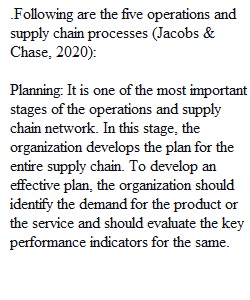


Q Six questions to be selected from the following list are as follows. 1. Select either Question 1 or 2 2. Select either Question 3, 4, or 5 3. Select either Question 6 or 7 4. Select either Question 9 or 14 5. Select either Question 10 or 11 6. Select either Question 12 or 13 Questions: 1. [Source: Chapter 1]: Define the five operations and supply chain processes. Discuss how each identified process can be applied to both a product and a service. 2. [Source: Chapter 2]: Explain the concept of supply chain risk. Discuss how the use of risk mapping can help identify and mitigate supply chain risk. Use a specific example to support your answer to this question. 3. [Source: Chapter 3]: Explain the difference between an exponential smoothing forecasting model and a regression forecasting model. Explain the supply chain assumptions linked to each model why it is important to validate these assumptions prior to the use of either the exponential smoothing forecasting model and a regression forecasting model. 4. [Source: Chapter 4]: Link the concept of long, intermediate, and short-range planning to forecasting strategies. Explain how the determination of capacity requirements and a capacity cushion links forecasting strategies to the concept of long, intermediate, and short-range planning. 5. [Source: Chapter 8]: Explain the concept of sales and operations planning and link this concept to both capacity planning and forecasting. Use a specific example to support your answer to this question. 6. [Source: Chapter 6]: Explain the make-to-stock process. Link this concept to and understanding of customer lead time and inventory investment. Use a specific example to support your answer to this question. 7. [Source: Chapter 7]: Relative to the platform service business model and service failsafing, explain how the concepts can be utilized to provide proper service while mitigating any potential risks to performance. Use a specific example to support your answer to this question. 8. [Source: Chapter 9]: Explain the concept of material requirements planning (MRP) and link this concept to inventory holding costs. Explain how each inventory holding cost is affected by MRP and how this analysis can mitigate supply chain risk. 9. [Source: Chapter 14]: When selecting location areas, what are six areas that require consideration. In your answer, define these areas. Then, how do these areas affect the effective operation of the total supply chain management process? 10. [Source: Chapter 10]: Explain how the analytical tools for Six Sigma and continuous improvement can be applied to assure the dimensions of design quality are achieved relative to supply chain management. Link this concept to supply chain risk mapping and to service fail-safing. Use a specific example to support your answer to this question. 11. [Source: Chapter 12]: Explain the concept of a value stream map, the value provided by utilizing a value stream map, and how statistical process control can be applied to the value stream map to help improve a supply chain process. 12. [Source: Chapter 11]: Explain the concept of inventory turns and link this to concepts of make-to-stock and forecasting theory. 13. [Source: Chapter 13]: Explain the concept of the bullwhip effect. What is some way to anticipate, mitigate, and prevent a bullwhip effect? If a bullwhip effect happens, what is the impact on the supply chain management process? 14. [Source: Chapter 14]: Explain what mode of transportation is involved in the movement of the greatest number of products; and what mode of transportation is limited to specialized products such as liquids and gases?
View Related Questions